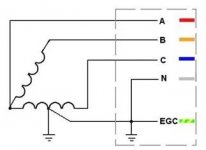Supplying loads B-N is discouraged. 240.15(B) requires a 3 pole breaker, so the handle tie question is moot.
10A in your example, assuming identical loads A-N and C-N (no phase difference). Then looking at just the paired loads A-N and C-N, they produce currents of (10, 0, 10) on (A, N, C). Looking just at the 10A load B-N, it produces currents of (10, 10) on (B, N). In general you'd have to add the currents on the neutral vectorially, but as one of the neutral currents is 0, the sum is just 10A.
Cheers, Wayne


